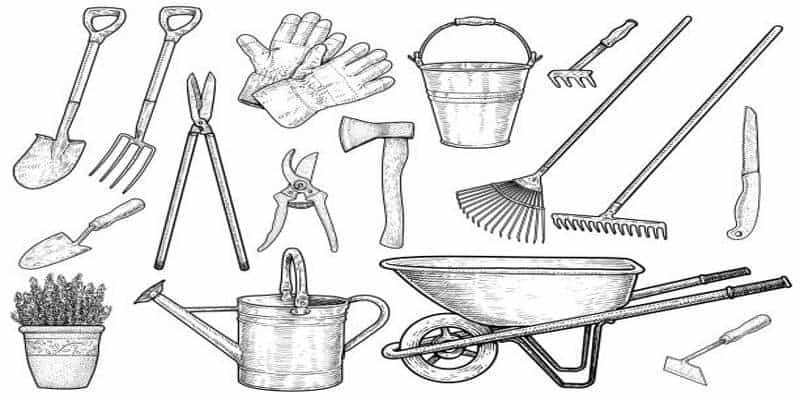Table of Contents
Simple Farm tools in Agriculture
Definition Of Simple Farm tools
Farm tools are simple, useful implements crafted by farmers or local artisans for basic farm work. Farmers who cultivate crops and keep animals typically employ a few simple tools to make their work easier and quicker.

Types Of Simple Farm Tools
Here are some popular, simple farm tools and their uses
1. Cutlass
The cutlass is the most essential device used by farmers. It is generally of two forms: One has a slightly curved blade and a short wooden handle, while the other has a straight blade and a short wooden handle. The metal blade has one sharp edge and one blunt side.
Uses/Functions Of The Cutlass
- For felling and clearing out bushes and trees.
- To transplant seedlings.
- In order to plant seeds and harvest farm crops.
- For weeding agricultural lands.
Maintenance Practices
- The cutlass should be regularly sharpened.
- Store it in a cool and dry location.
- Before storage, metal components should be cleaned or oiled.
- It should not be left on the ground.
2. Hoe
The hoe consists of a solid blade that may be round or slightly oval and a wooden handle that may be long or short.
Uses/Functions Of The Hoe
- The hoe is used to prepare the land for operations.
- It is used to create heaps and ridges.
- For sowing or transplanting certain plants.
- For harvesting certain crops
- It is implemented for weeding.
Maintenance Practices
- Sharpen dull blades.
- Store in a dry, cool environment.
- Clean, and apply oil on the metal blade before storage.
- Wash or clean thoroughly after handling.
3. Rake
A rake is a farm tool with a long wooden or metal handle that has a metal attachment with prong or teeth-like structure.
Functions and Applications
- It used to gather debris and waste products
- To harvest some corps
- It is used in the clearing of the farmland
- It ua used to level the soil surface
Maintenance Techniques
- Store the tool in a cool, dry location.
- Clean properly after usage
- To prevent rusting, rub metal attachment with oil or grease.
4. Spade
A spade is a tool with a long metal handle and a wide metal blade. The metal blade’s edge is sharp, allowing it to easily penetrate the land.
Functions and Applications
- A spade is used to lift soil and turn it perfectly over.
- It’s used to level the ground.
- To dig holes during the transplanting process.
- Cement/concrete mixing for farm constructions.
Maintenance Techniques
- Keep the tool in a dry and cool environment.
- Protect wooden handles from water and termite attack.
- Regularly sharpen the blade.
5. Shovel
A shovel is similar to a spade. A shovel’s handle is long, but the blade is hollow and broad, with a rectangular blade.
Shovel Functions and Applications
- It is used to lift or move soil from one location to another.
- To create garden paths
- To level the soil and remove stones and trash.
- To lift materials into a wheel barrow from the ground level.
Maintenance Techniques
- Keep the tool in a dry and cool environment.
- Coat metal parts with oil, grease, or paint.
- Wipe clean after each use.
6. Garden forks
Garden forks have four long pointed prongs or teeth. The hard metal prongs are about 20cm long and are positioned on a 70-80cm long steel or wooden handle.
Garden Fork Functions and Applications
- It is used to turn manure during the composting process.
- It’s used to soften the soil in preparation for transplanting.
- It’s also used to transfer manure.
- It’s can be used to load hay.
Maintenance Techniques
- Use grease to prevent rust.
- Always clean the tool after usage
- Store in a dry, cool location.
- Prior to long storage, paint metal parts.
7. Hand Fork
The hand fork is made up of four or five short flat prongs on a metal piece. Some are made entirely of metal, and some have a small wooden handle.
Hand Fork Functions and Applications
- It’s used to loosen surface soil or break up clods of soil.
- It is utilized for light weeding
- To mix soil or manure together.
- To add manure to the soil
Maintenance Techniques
- Keep the tool in a dry and cool environment.
- To prevent rust, use paint, oil, or grease.
- After each use, clean or wash it.
Other basic farm tools include:
- Basket
- Axe
- Pick Axe or Digger
- Headpan
- Watering can
- Spanner
- Mattock
- Sickle
- Hand trowel
- Harvesting knife
- Root-loading Fork
- Hayfork
- Shears
- Manure Drag
- Wheelbarrow
- Crowbar
- Bradawl
- Budding knife
- Secateurs
- Hammer
- Pliers
- Screwdriver
- Nut and Bolt
- File or Chisel
Maintenance Of Simple Farm Tools And Implements
- To extend the “life span” and effective use of farm tools, the following maintenance measures or precautions should be followed.
- After each use, wash or clean the tools.
- To reduce friction, oil, grease, or lubricate movable joints.
- Store applicable tools upside-down to allow water to drain where it is needed, such as a watering can.
- If needed, sharpen blunt edges or blades.
- If relevant, paint, oil, or grease metallic portions to prevent rust.
- Keep the container cool and dry.
- Replace any worn-out components.
- Screw back loosen nuts and bolts on a daily or periodic basis.
- Before using any equipment, read the operating manual.
- Use tools with caution and only for their intended purposes.


